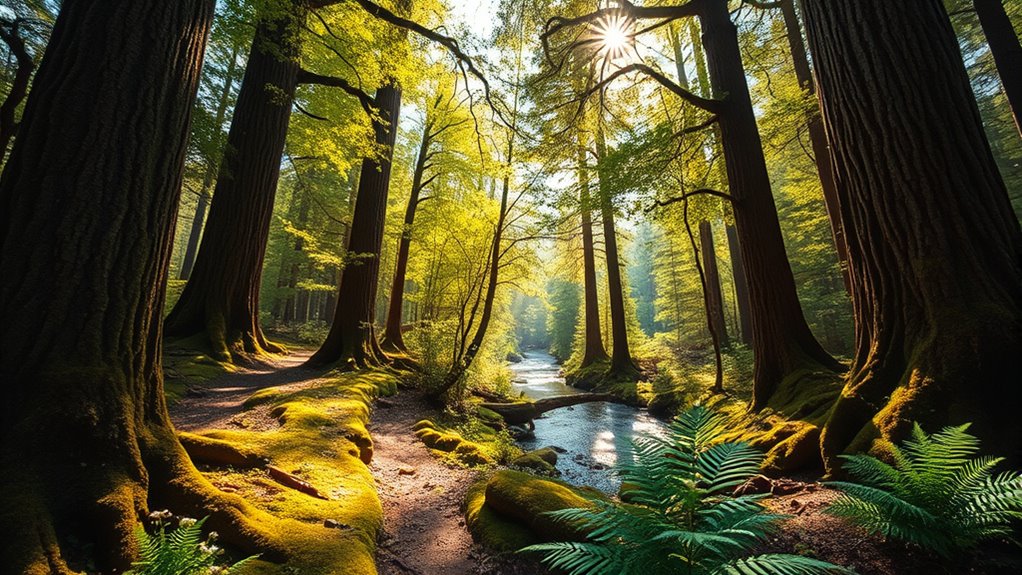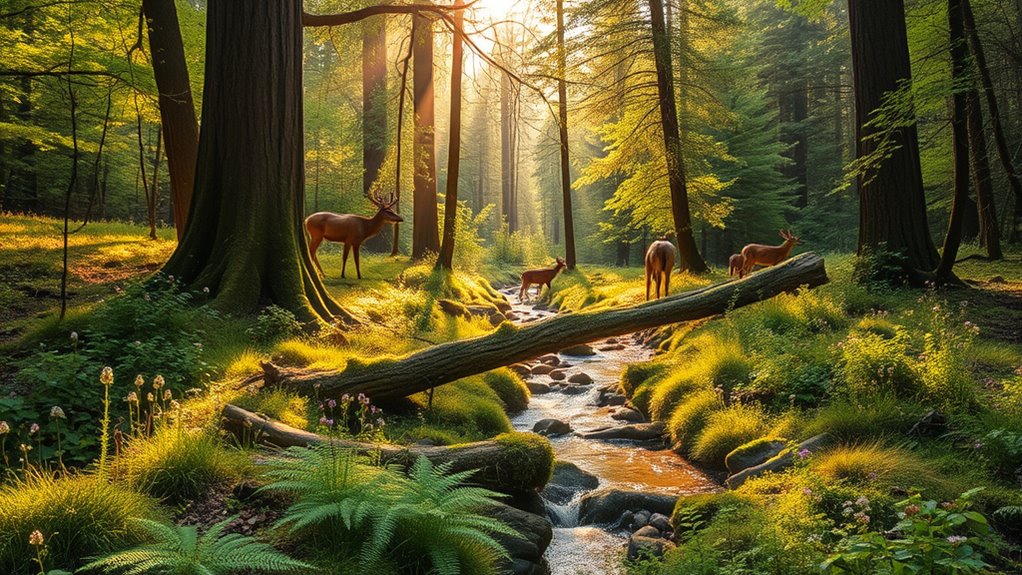Rewilding helps you reconnect with Earth’s natural rhythms by restoring habitats and creating wildlife corridors that allow animals to move freely. It supports biodiversity and natural ecological processes like pollination and seed dispersal, which keep ecosystems healthy and resilient. As you engage with rewilding efforts, you’ll notice ecosystems functioning more smoothly, fostering harmony between humans and nature. Keep exploring how these actions can deepen your bond with the environment and sustain life for future generations.
Key Takeaways
- Rewilding restores natural habitats, allowing ecosystems to regain their ecological rhythms and support native species.
- Connecting fragmented landscapes through wildlife corridors enhances animal movement and ecosystem resilience.
- Rewilding promotes biodiversity, pollination, seed dispersal, and pest control, vital for healthy ecological processes.
- Restoring natural pathways and habitats helps ecosystems adapt to environmental changes and supports human well-being.
- Emphasizing rewilding fosters sustainable relationships between humans and nature, ensuring future ecological balance.

Have you ever wondered how restoring natural habitats can benefit both wildlife and people? It all comes down to eco restoration, a process that helps bring degraded ecosystems back to life, ensuring that plants, animals, and humans can thrive together. One of the most effective strategies in eco restoration is creating wildlife corridors, which serve as essential pathways connecting fragmented habitats. These corridors allow animals to move freely across landscapes, access different food sources, find mates, and adapt to environmental changes. Without such connections, many species become isolated, leading to reduced genetic diversity and increased risk of extinction. By establishing wildlife corridors, you’re helping to maintain healthy, resilient populations and supporting the natural rhythms of ecosystems.
Restoring habitats with wildlife corridors helps ecosystems thrive and promotes coexistence between humans and nature.
When you focus on eco restoration through the development of wildlife corridors, you’re actively reversing the effects of habitat destruction caused by urbanization, agriculture, and infrastructure development. Instead of isolated patches of wilderness, these corridors create a network that mimics the natural pathways animals once used. This connectivity not only supports biodiversity but also promotes ecological processes like pollination, seed dispersal, and pest control. As a result, ecosystems become more balanced and productive, benefiting both wildlife and nearby communities. People who live close to restored habitats often notice improved air and water quality, reduced flooding, and enhanced recreational opportunities, all of which contribute to a better quality of life. Additionally, restoring natural habitats also helps maintain ecological processes such as pollination, which are vital for sustainable agriculture and food production.
Restoring natural habitats through eco restoration also encourages a deeper appreciation for nature’s rhythms. When ecosystems are healthy and connected, they operate more smoothly, maintaining the delicate balance that sustains life. For you, this means a chance to reconnect with the environment, witness the return of native species, and experience the calming effects of nature. It’s about understanding that human activities can either fragment or unify the landscape. By supporting initiatives that create wildlife corridors, you’re helping to restore the natural flow of life, ensuring that ecosystems can adapt to changing conditions and continue to provide essential services.
In essence, eco restoration and wildlife corridors are more than conservation tools—they’re pathways to a sustainable future. When you invest in these efforts, you’re fostering resilient ecosystems that function in harmony with natural rhythms, ultimately benefiting all living beings. Restoring habitats isn’t just about saving species; it’s about re-establishing a crucial connection between humans and the world around us. This connection sustains our own well-being and helps preserve the planet’s incredible diversity for generations to come.
Frequently Asked Questions
How Does Rewilding Impact Local Economies?
Rewilding boosts local economies by attracting eco-tourism, which increases visitors and revenue. This creates more local employment opportunities in hospitality, guiding, and conservation efforts. As you support rewilding initiatives, you help sustain small businesses and encourage environmental awareness. The economic benefits grow as communities embrace eco-friendly practices, ensuring long-term prosperity while preserving natural landscapes. Your involvement directly contributes to a thriving local economy rooted in sustainable, nature-based tourism.
What Are the Biggest Challenges in Rewilding Projects?
You’ll face significant challenges in rewilding projects, especially with habitat restoration and managing invasive species. Restoring natural habitats requires careful planning and resources, while invasive species can outcompete native ones, disrupting ecosystems. You need to develop effective strategies to control these species and ensure native plants and animals thrive. Overcoming these obstacles demands collaboration, patience, and ongoing effort to successfully rewild and reconnect ecosystems with their natural rhythms.
Can Rewilding Be Implemented in Urban Areas?
Yes, you can implement rewilding in urban areas by transforming urban green spaces into thriving habitats and encouraging community involvement. You can create native plant gardens, install bird and bee habitats, and restore natural water features. By engaging local residents, schools, and organizations, you foster stewardship and awareness. This approach not only enhances biodiversity but also reconnects people with nature, making cities healthier and more resilient places to live.
How Do Rewilding Efforts Affect Biodiversity?
Rewilding efforts boost biodiversity by restoring native species and creating habitats that support diverse plants and animals. When you rewild an area, you help strengthen ecosystem resilience, making it better able to withstand environmental changes and threats. This process encourages natural processes to take over, leading to healthier, more balanced ecosystems. As a result, native species thrive, and overall biodiversity increases, benefiting both local environments and the broader ecological network.
What Role Do Indigenous Communities Play in Rewilding?
Indigenous communities play a crucial role in rewilding through indigenous stewardship and traditional knowledge. You should recognize that their deep understanding of local ecosystems guides sustainable practices and habitat restoration. By collaborating with these communities, you guarantee that rewilding efforts respect cultural values and leverage centuries-old insights, ultimately enhancing biodiversity and ecosystem resilience. Embracing indigenous leadership helps create more effective, respectful, and lasting conservation outcomes.
Conclusion
By embracing rewilding, you’re helping nature’s heartbeat regain its rhythm. Imagine yourself as the gentle conductor, guiding ecosystems back to harmony. Every small action you take is like planting a seed of change, growing a future where wildlands flourish and wildlife thrives. Rewilding isn’t just about nature; it’s about reconnecting with the wild within you. Together, you and the Earth can dance to a more natural, vibrant tune—restoring balance one step at a time.








